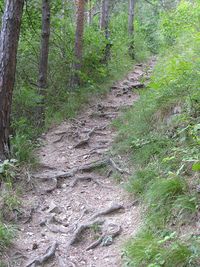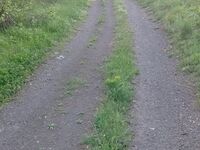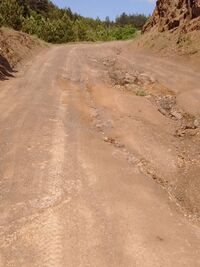ES:Key:smoothness
| Descripción |
|---|
| Proporcionar un esquema de clasificación con respecto a la usabilidad física de una vía para vehículos con ruedas. |
| Grupo: propiedades |
| Usado en estos elementos |
| Combinaciones útiles |
| Estado: aprobado |
| Herramientas para esta etiqueta |
Si comprendes el artículo original en inglés, por favor, ayuda a completar esta traducción al español. Lee las instrucciones sobre cómo traducir este wiki.
Broiledpeas está trabajando ahora en esta traducción.
smoothness (“suavidad”) proporciona un esquema de clasificación relativo a la usabilidad física de una vía para los vehículos de ruedas, en particular en lo que se refiere a la regularidad/planeza de la superficie. La utilizabilidad por un tipo concreto de vehículo significa que éste puede atravesar la vía sin riesgo significativo de sufrir daños (por ejemplo, en el tren de rodaje o la cadena cinemática) o lesiones (por ejemplo, por caída). La etiqueta puede aplicarse a todas las vías y zonas transitables: highway=*, zonas de aparcamiento, playas, etc.
El objetivo de esta etiqueta debe ser que los desarrolladores de software de navegación puedan utilizar su información para proponer una ruta óptima en función del vehículo que utilice el usuario. Muchos ya ofrecen rutas para coches, bicicletas, peatones y transporte público: ¿no estaría bien que pudieran añadir rutas para patinadores, todoterrenos, 4x4, etc.? Por lo tanto, como cartógrafo, cuando utilices esta etiqueta, deberías preguntarte: "¿Estará contenta la mayoría de la gente si su software de rutas le sugiere tomar este camino con sus patines/bicicleta de carreras/coche deportivo/coche normal de pasajeros/SUV/4WD/tractor, o preferirían tomar un camino alternativo (supongamos que lo hay) con una superficie más lisa y un 30% más largo?".
tracktype=* también es una propiedad superficial importante y se refiere a la firmeza de la superficie, independientemente de la forma.
surface=* se refiere al material de la superficie y, a veces, a la estructura del material. A veces puede sugerir una suavidad de la superficie, pero como el mismo material/estructura de la superficie puede presentar diversas formas, sigue siendo aconsejable añadir smoothness=*.
Values
Smoothness
| Key | Value | Element | Usable by | Description | Photo |
|---|---|---|---|---|---|
| smoothness | excellent | (thin_rollers) roller blade, skate board and all below | As-new asphalt or concrete, smooth paving stones with seamless connections, etc. | 
| |
| smoothness | good | (thin_wheels) racing bike, sport motorcycles and all below | Asphalt or concrete showing the first signs of wear, such as narrow (<1.5 cm) cracks, wider cracks filled up with tar, shallow dents in which rainwater may collect, etc. that may cause trouble for rollers but not for racing bikes. The best roads paved with bricks, sett, etc. also fall in this category. | 
| |
| smoothness | intermediate | (wheels) city bike, sport cars, wheel chair, cruiser/touring motorcycles, Scooter and all below | Asphalt and equivalent that shows signs of maintenance such as patches of repaired pavement, wider cracks (>2 cm), etc. that may cause trouble for racing bikes. The pavement may contain potholes, but these are small, shallow (<3cm deep) and few so they are easily avoided, or the road shows damage due to subsidence (depressions of a scale >50 cm) or heavy traffic (shallow ruts in asphalt caused by trucks in summer). The quality of the surface starts to affect the speed of most passenger cars, so they will slow down to make the ride more comfortable (but still above 50% of the speed they would drive at if the road was smooth). The best unpaved but compacted roads fall in this category. | 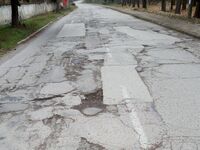
| |
| smoothness | bad | (robust_wheels) trekking bike, normal cars, commuter/standard motorcycles, Rickshaw and all below | Heavily damaged paved roads that badly need maintenance: many potholes, some of them quite deep. The average speed of cars is less than 50% of what it would be on a smooth road. However, it isn’t so rough that ground clearance becomes a problem. A ground clearance of a normal passenger car (>14 cm) is sufficient. Good unpaved roads without risk of damage to normal passenger cars are also included here. |  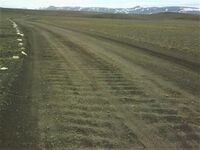
| |
| smoothness | very_bad | (high_clearance) Car with high clearance, light-duty off road vehicles, adventure motorcycles (>180kg) | Unpaved roads with potholes and ruts, but still passable with an average SUV with a ground clearance of at least 18 cm.* | 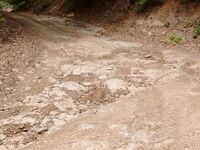
| |
| smoothness | horrible | (off_road_wheels) heavy-duty off road vehicles, dual-sport motorcycles (< 180kg) and all below | Unpaved tracks with ruts, rocks etc that need a ground clearance of at least 21 cm (Toyota Landcruiser, Landrover, Lada Niva, bukhanka, etc.). Skid plate protection is advisable. | 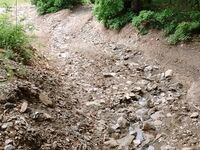
| |
| smoothness | very_horrible | (specialized_off_road_wheels) tractor, ATV, tanks, Trial/Enduro motorcycles (<130kg), Mountain bike and all kind of off-highway vehicles (see also mtb:scale=*) | Tracks with deep ruts and other obstacles that need a ground clearance of at least 24 cm. | 
| |
| smoothness | impassable | No wheeled vehicle | Ways, often highway=path, that are not passable by any vehicles, not even mountain bikes or specialised off-road vehicles, but are recognisable in the landscape and may still be useful for hikers. Consider also lifecycle prefixes disused:*=* or abandoned:*=* if the way used to be a passable road but has deteriorated. | 
|
Please note: Photos are examples ONLY! The smoothness of a way should be assessed solely based on whether the way is usable by the vehicles mentioned above. A user of a certain road or path is only interested in whether the road can be driven or not. *Note that some unpaved tracks can be so steep that a car designed mostly for on-road use does not have the gear ratios and engine power needed to drive up a slope slow enough not to cause damage without the engine stalling. The track may still be smooth enough that such cars can drive down that slope without problem, so in such cases the track should be marked bad but the steep section tagged with incline=*.
This table is a wiki template with a default description in English. Editable here.
Also see the gallery of example photos broken down by surface=* type.
Other gallery: gallery 2
Variations in smoothness
Roads will vary in smoothness along their length. If a road is good in one part, but gets worse later, it’s worth splitting the road and tag each one with the appropriate smoothness tag. If for instance a dead-end road up a mountain valley needs a 4WD to reach the end, but a nice lake halfway up can be reached by normal car, then split the road at the lake and tag the first part as bad or better, and the second part as horrible. But don’t overdo it: if there’s a small “intermediate” section with a few repaired patches in an otherwise “good” road, most racing bike riders will not want to take a detour to avoid it but just be careful on the bad section, so such a road should be tagged good.
Roads can also vary in smoothness along their width. Such a road should be tagged with the quality of its best passable part. If for instance an unpaved road has deep ruts, but there’s enough space next to the ruts on one side so a normal car can drive on it with one rut in between the wheels, it should be tagged as smoothness=bad.
Usage
This tag isn't in use on the renderers at www.openstreetmap.org, but Hiking/mri and the Motorcycle map of Romania are using "surface" and "smoothness" to depict the real state of roads.
In developing countries, the HDM model is using some values of smoothness=* to help define road quality.
Certain navigation applications use smoothness information to propose an optimal route depending on the vehicle the user is using (e.g., road bike / city bike / mountain bike).
OsmAnd shows smoothness and surface, if enabled in the menu (Confgure map - Details). Here is the map key with the rendering for each smoothness and surface value.
http://www.roads-bg.eu shows the smoothness of the road network in Bulgaria using 4 colours that correspond to smoothness=excellent+smoothness=good (green), smoothness=intermediate (yellow), smoothness=bad (red) and smoothness=very_bad (dark red). Site visitors can suggest additions to the data.
Initial controversy
Discussions on the mailing lists around 2008 point out that part of the community did not like this key, based on a lack of verifiability — cf. [1], continued at [2]. As always on OSM you are free to use the keys you like in the way you like. See Talk:Accepted features/Smoothness for details on the controversial nature of this key. An initial effort to unify surface=* tagging was proposed, but this approach was abandoned.
See also
- surface=* - Describes the surface of a feature
- tracktype=* - Provides a classification of tracks
- sac_scale=* - classify hiking trails in mountainous areas with regard to the difficulties to be expected
- Approved smoothness proposal page - for further discussion of the tag
- Humanitarian OSM Tags/smoothness
- Projects, monitoring surface quality of roads via build-in accelerometer (smart-phone, tablet, etc.):
- https://smartroadsense.it
- WorldBank-Transport/RoadLab-Pro GitHub
- https://roadroid.com (commercial)
